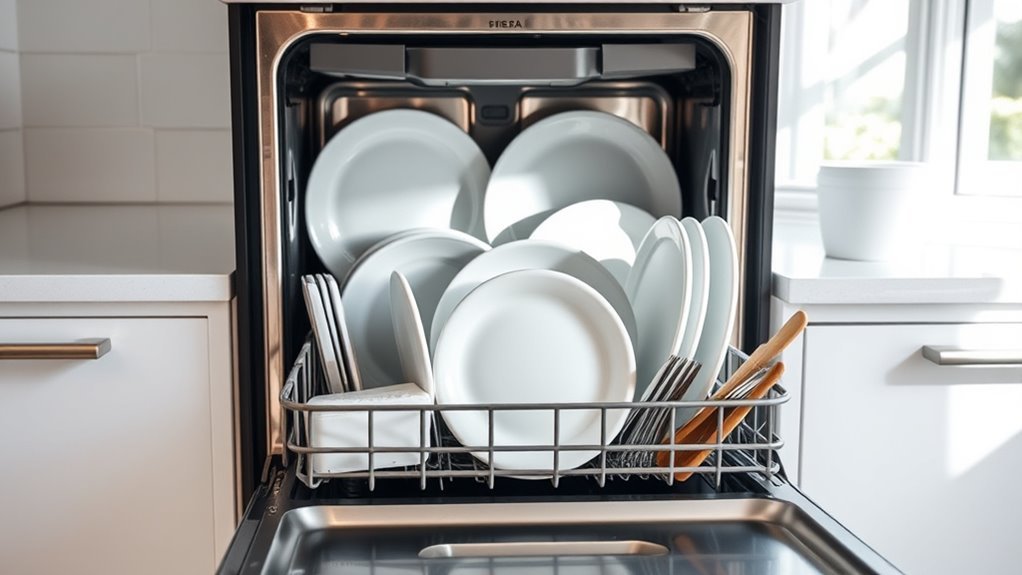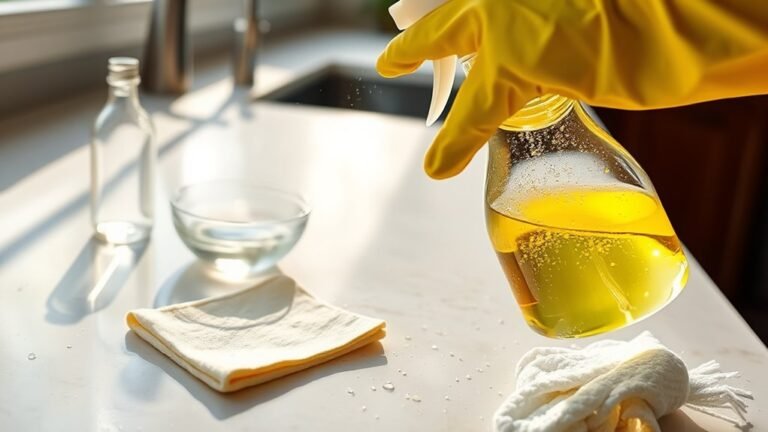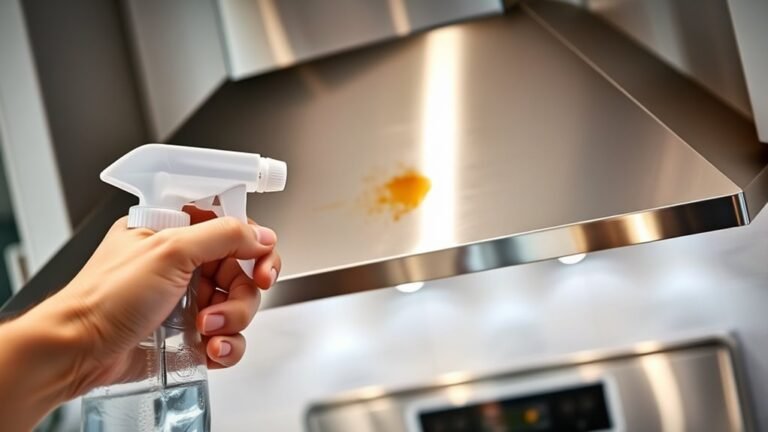Cleaning With Dishwasher: What Works and What Doesn’T
To get dishes truly clean in your dishwasher, use detergents formulated for your water type and set the water temperature between 120°F and 150°F. Choose cycles based on soil level—for example, heavy duty for pots and delicate for glass. Avoid putting wood, fragile ceramics, or non-dishwasher plastics inside. Pre-scrape and pre-soak stubborn residues, and maintain your machine by cleaning filters and spray arms regularly. Understanding these fundamentals guarantees spotless results and efficiency; more insights can help you optimize every wash.
Understanding Dishwasher Detergents and Their Effectiveness

How do dishwasher detergents work to achieve spotless results? You should know that their effectiveness hinges on carefully formulated dishwasher ingredients designed to break down food residues and grease efficiently. These ingredients typically include surfactants, which reduce surface tension and lift grime; enzymes that target proteins and starches; and bleaching agents to remove stains. Additionally, water softeners prevent mineral buildup, ensuring a thorough clean. Understanding this composition helps you appreciate why selecting a detergent suited to your water hardness and soil level is vital for peak performance. By grasping how these components interact during a wash cycle, you gain control over your cleaning routine, freeing yourself from trial and error and ensuring your dishes come out consistently spotless.
Choosing the Right Dishwasher Cycle for Different Loads
You’ll want to select the dishwasher cycle based on the type and soil level of your load. Heavy duty cycles are ideal for pots and pans with stubborn grime, while delicate cycles protect fragile items like glassware. For everyday dishes, energy-saving cycles reduce water and electricity use without compromising cleanliness.
Heavy Duty Cycle Benefits
Although it might be tempting to use a quick cycle for all your dishes, selecting the heavy duty cycle when dealing with heavily soiled pots, pans, and casseroles guarantees a more thorough clean. The heavy duty cycle advantages lie in its longer wash time, higher water temperature, and increased pressure, which effectively break down baked-on food and grease. This cycle is specifically designed to handle tough grime, ensuring your cookware comes out spotless without extra scrubbing. By choosing the heavy duty setting, you free yourself from pre-rinsing and avoid multiple wash cycles. It’s a precise, reliable option that maximizes cleaning power when you need it most, giving you confidence that even your most stubborn messes won’t hold you back.
Delicate Cycle Use Cases
When handling fragile items like glassware, fine china, or delicate plastics, the delicate cycle is your best choice. This cycle uses lower water pressure and gentler temperatures, protecting fragile glassware from chips or cracks. You’ll also find it ideal for cleaning dishwasher-safe items made from delicate fabrics, such as reusable cloth napkins or padded utensil holders, ensuring they retain their quality. Choosing the delicate cycle helps prevent damage while still providing effective cleaning, especially when you want to preserve your valuable or sentimental pieces. Be mindful to arrange items carefully, avoiding overcrowding to allow water and detergent to reach all surfaces. By selecting the right cycle for delicate loads, you maintain the longevity of your kitchenware and enjoy peace of mind every time you run your dishwasher.
Energy-Saving Cycle Options
Since energy efficiency matters to both your utility bills and the environment, selecting the right dishwasher cycle can make a significant difference. When considering cycle selection, opt for energy-saving cycles designed for lightly soiled or smaller loads. These cycles use lower temperatures and shorter wash times, reducing electricity and water consumption without compromising cleanliness. Avoid heavy or prolonged cycles unless necessary, as they increase energy use unnecessarily. Many modern dishwashers feature eco or quick wash options—perfect for maintaining energy efficiency while ensuring your dishes get clean. By matching cycle selection to the load type and soil level, you gain control over energy use, lowering costs and environmental impact. This thoughtful approach to dishwasher use aligns with your desire for freedom from waste and inefficiency.
Items That Clean Well in a Dishwasher
Because dishwashers use high temperatures and powerful jets, certain items consistently come out spotless and sanitized. You’ll find dishwasher safe cookware, like stainless steel pots and pans, thoroughly cleaned without damage. Ceramic plates and glassware also withstand the process well, emerging gleaming and residue-free. Cleaning utensils made from durable plastics or metals are ideal for the dishwasher’s intense cycles, freeing you from tedious scrubbing. Just verify these items are labeled dishwasher safe to avoid warping or discoloration. By loading these compatible items properly, you maximize cleanliness while preserving their condition. This methodical approach lets you reclaim time and effort, offering freedom from manual washing without sacrificing hygiene or appliance longevity.
Common Kitchenware That Shouldn’t Go in the Dishwasher

You shouldn’t put delicate materials in the dishwasher, as the harsh cycles can cause damage. Wooden items are especially vulnerable to heat and moisture, which can lead to warping or cracking. Also, avoid plastics not labeled dishwasher-safe since they may melt or degrade during cleaning.
Delicate Materials Risk Damage
Although dishwashers offer convenience, certain delicate materials can suffer irreversible damage when exposed to their high heat and harsh detergents. You’ll want to avoid placing delicate fabrics and fragile ceramics inside the dishwasher, as the intense environment can cause fading, cracking, or warping. To protect your items, it’s essential to recognize what won’t withstand dishwasher cycles.
| Material Type | Risk Factors | Recommended Action |
|---|---|---|
| Delicate Fabrics | Shrinking, color fading | Hand wash or air dry |
| Fragile Ceramics | Cracking, chipping | Wash by hand with care |
| Thin Glassware | Etching, breakage | Use top rack or hand wash |
| Painted Surfaces | Paint peeling | Avoid dishwasher |
Wooden Items Avoid Heat
When wooden kitchenware is exposed to the dishwasher’s high heat and moisture, it can warp, crack, or lose its finish. You’ll want to avoid this heat damage to preserve your wood care routine and prolong the life of wooden spoons, cutting boards, and bowls. The intense temperature fluctuations and saturated environment inside the dishwasher break down the wood fibers, causing irreversible damage. Instead, wash wooden items by hand with mild soap and warm water, then dry them thoroughly to prevent moisture absorption. Applying mineral oil or specialized wood conditioners regularly helps maintain their integrity and appearance. By steering clear of the dishwasher for wooden kitchenware, you guarantee both their functionality and natural beauty remain intact for years to come.
Non-Dishwasher Safe Plastics
Just as wooden items require careful handling to maintain their quality, certain plastics also need special attention to avoid damage in the dishwasher. Non dishwasher safe plastics can warp, discolor, or leach harmful chemicals when exposed to high heat. To preserve your kitchenware’s integrity and maintain your freedom to reuse them, consider alternative cleaning methods such as hand washing with mild detergent or using cold water cycles.
| Plastic Type | Issue in Dishwasher |
|---|---|
| Thin disposable | Warping, melting |
| Insulated containers | Warping, seal damage |
| Plastic cutting boards | Warping, surface damage |
| Food storage lids | Warping, loss of shape |
| Non-labeled plastics | Unknown risk, avoid |
Avoid putting non dishwasher safe plastics in the dishwasher for lasting use and safety.
How to Pre-Treat Stubborn Food Residue Before Washing

Dealing with stubborn food residue effectively starts with a thorough pre-treatment process that guarantees your dishwasher can handle the load without leaving behind debris. Before loading, consider these pre soaking techniques to soften hardened particles and reduce the dishwasher’s burden:
- Rinse dishes briefly under warm water to loosen surface residue.
- Soak pots or pans with burnt or dried-on food in warm, soapy water for 15–30 minutes.
- Use a soft brush or sponge to gently scrub off tough spots without damaging surfaces.
- Avoid harsh chemicals; opt for mild detergents that aid in breaking down food residue.
- For extreme cases, a mixture of baking soda and water can help lift stubborn stains before washing.
Tips for Maintaining a Clean and Efficient Dishwasher
Properly pre-treating your dishes helps prevent residue buildup, but keeping your dishwasher itself clean is equally important for peak performance. Start by routinely checking and cleaning the filter to avoid clogs and odors. Wipe down door seals and spray arms to remove debris that can hinder water flow. Use dishwasher maintenance tips like running an empty cycle with a dishwasher cleaner monthly to dissolve mineral deposits. Efficient loading techniques matter: avoid overcrowding, place items with soiled surfaces facing spray arms, and guarantee nothing blocks detergent dispensers. This methodical approach improves wash quality and extends your machine’s lifespan. By adopting these simple yet effective habits, you’ll maintain a cleaner, more efficient dishwasher that frees you from constant scrubbing and keeps your kitchen running smoothly.
The Role of Water Temperature in Dishwasher Cleaning
Water temperature plays an essential role in how effectively your dishwasher cleans. Understanding the water temperature impact helps you access your dishwasher’s full potential. If the water isn’t hot enough, detergent won’t dissolve properly, leaving residue and grime behind. Conversely, excessively hot water can damage delicate items and waste energy. Aim for ideal heating settings around 120°F to 150°F for efficient cleaning.
Optimal dishwasher water temperature between 120°F and 150°F ensures effective cleaning without damaging dishes.
Consider these factors to maximize your dishwasher’s performance:
- Verify your home water heater is set within the recommended range
- Use the dishwasher’s heated dry cycle for consistent temperature
- Pre-rinse only when necessary to avoid cooling the water
- Avoid overloading to maintain water circulation and temperature
- Select cycles designed for specific soil levels and temperature needs
Mastering these controls gives you freedom from re-washing and guarantees spotless results.
Addressing Hard Water and Its Impact on Dishwasher Performance
Although hard water is common in many areas, it can significantly hinder your dishwasher’s cleaning efficiency by leaving mineral deposits on dishes and inside the machine. These hard water effects cause mineral buildup that reduces water flow, clogs spray arms, and dulls your glassware. To maintain peak performance, you need to address these issues consistently.
| Problem | Solution |
|---|---|
| Mineral buildup on dishes | Use a rinse aid or vinegar rinse |
| Clogged spray arms | Clean spray arms regularly |
| Scale inside dishwasher | Run a dishwasher cleaner monthly |
| Dull glassware | Use water softening agents |
| Reduced water flow | Check and clean filters |
Eco-Friendly Practices for Dishwasher Use
When you want to minimize your environmental impact, using your dishwasher efficiently is key. Choosing sustainable detergents helps reduce harmful chemicals in wastewater. Additionally, maximizing energy efficiency lowers your household’s carbon footprint and saves on utility bills.
To adopt eco-friendly dishwasher practices, consider these steps:
Consider these steps to make your dishwasher use more eco-friendly and efficient.
- Run full loads only to conserve water and electricity.
- Select eco or energy-saving cycles tailored for light soil.
- Use sustainable detergents free from phosphates and harsh chemicals.
- Skip pre-rinsing; modern dishwashers clean effectively without it.
- Regularly maintain your dishwasher to guarantee peak performance and energy use.
Frequently Asked Questions
Can Dishwashers Sanitize Baby Bottles Effectively?
Oh sure, just toss those baby bottles into your dishwasher and hope for the best—because who needs actual baby bottle sanitization, right? But if you want to be methodical, you’ll use high-heat dishwasher settings with a sanitize cycle to kill germs effectively. Relying on a regular wash won’t guarantee safety. So, if you cherish your baby’s health and your freedom from worries, choose your dishwasher settings wisely for true sanitization.
How Often Should Dishwasher Filters Be Cleaned?
You should prioritize regular filter maintenance to keep your dishwasher running efficiently. Cleaning frequency depends on usage, but generally, you’ll want to clean the filter every one to two months. If you use your dishwasher daily or wash heavily soiled items often, consider more frequent cleaning. This prevents clogs, improves water flow, and guarantees your dishes come out spotless. Staying on top of filter maintenance gives you freedom from unexpected breakdowns or poor cleaning results.
Is It Safe to Wash Wooden Utensils in a Dishwasher?
When it comes to wooden utensils, it’s best not to put all your eggs in one basket by tossing them in the dishwasher. Dishwasher safety for wooden utensils is questionable because the heat and water can cause cracking, warping, or fading. Instead, hand wash them gently with mild soap and dry immediately. This way, you’ll keep your wooden tools in great shape and enjoy their natural charm for years to come.
What Causes Dishwasher Odors and How to Eliminate Them?
Dishwasher odors mainly come from trapped food particles and stagnant water. To prevent this, you need regular dishwasher maintenance. Start by cleaning the filter and spray arms to remove debris. Run an empty cycle with vinegar or a dishwasher cleaner monthly to break down buildup. Also, leave the door slightly open after cycles to air it out, ensuring odor prevention. These steps keep your dishwasher fresh and working freely without unpleasant smells.
Can Dishwasher Use Reduce the Spread of Germs in the Kitchen?
Like a modern-day shield against unseen invaders, your dishwasher plays an essential role in germ reduction. By using high temperatures and strong water jets, it effectively eliminates bacteria that handwashing might miss. This contributes greatly to kitchen hygiene, lowering the risk of cross-contamination. So, you’re not just cleaning dishes—you’re safeguarding your freedom to enjoy a healthier, safer cooking environment with less worry about germs lurking around.






